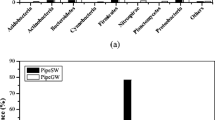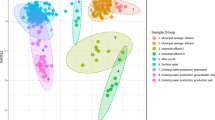Abstract
Microbial regrowth in drinking water distribution systems (DWDS) is a major concern in the water supply industry. Detailed knowledge of the microbial community in DWDS will be of great importance for assessing the microbiological risks of drinking water. The spatial heterogeneity of microbial community structures in the bulk waters of a large real DWDS was investigated using 16S rRNA clone library analysis. The results indicate that high residual chlorine in drinking water could not control microbial regrowth in DWDS. The bacterial communities in the bulk waters were spatially heterogenic, mainly composed of Alphaproteobacteria and Betaproteobacteria (or Cyanobacteria). Microorganisms from the genera Acinetobacter, Sphingomonas and Gemella were detected, implying there is microbiological risk from drinking water. This work provides new insight into microbial ecology in DWDS.
Similar content being viewed by others
References
Brettar, I. and M. G. Höfle (2008) Molecular assessment of bacterial pathogens-a contribution to drinking water safety. Curr. Opin. Biotechnol. 19: 274–280.
Berry, D., C. W. Xi, and L. Raskin (2006) Microbial ecology of drinking water distribution systems. Curr. Opin. Biotechnol. 17: 297–302.
Lillis, T. O. and G. K. Bissonnette (2001) Detection and characterization of filterable heterotrophic bacteria from rural groundwater supplies. Lett. Appl. Microbiol. 32: 268–272.
Kormas, K. A., C. Neofitou, M. Pachiadaki, and E. Koufostathi (2010) Changes of the bacterial assemblages throughout an urban drinking water distribution system. Environ. Monit. Assess. 165: 27–38.
Revetta, R. P., A. Pemberton, R. Lamendella, B. Iker, and J. W. S. Domingo (2010) Identification of bacterial populations in drinking water using 16S rRNA-based sequence analyses. Water Res. 44: 1353–1360.
Farnleitner, A. H., F. Zibuschka, M. M. Burtscher, G. Lindner, G. Reischer, and R. L. Mach (2004) Eubacterial 16S-rDNA amplicon profiling: A rapid technique for comparison and differentiation of heterotrophic plate count communities from drinking water. Int. J. Food Microbiol. 92: 333–345.
Lee, D. G., J. H. Lee, and S. J. Kim (2005). Diversity and dynamics of bacterial species in a biofilm at the end of the Seoul water distribution system. World J. Microbiol. Biotechnol. 21: 155–162.
Yu, J., D. Kim, and T. Lee (2010) Microbial diversity in biofilms on water distribution pipes of different materials. Water Sci. Technol. 61: 163–171.
Mathieu, L., C. Bouteleux, S. Fass, E. Angel, and J. C. Block (2009) Reversible shift in the α-, β- and γ-proteobacteria populations of drinking water biofilms during discontinuous chlorination. Water Res. 43: 3375–3386.
Regan, J. M., G. W. Harrington, and D. R. Noguera (2002) Ammonia- and nitrite-oxidizing bacterial communities in a pilotscale chloraminated drinking water distribution system. Appl. Environ. Microbiol. 68: 73–81.
Martiny, A. C., H. -J. Albrechtsen, E. Arvin, and S. Molin (2005) Identification of bacteria in biofilm and bulk water samples from a non-chlorinated model drinking water distribution system: Detection of a large nitrite-oxidizing population associated with Nitrospira spp. Appl. Environ. Microbiol. 71: 8611–8617.
Lindström, E. S. (2000) Bacterioplankton community composition in five lakes differing in trophic status and humic content. Microb. Ecol. 40: 104–113.
Huang, Y., L. Zou, S. Y. Zhang, and S. G. Xie (2011) Comparison of bacterioplankton communities in three heavily polluted streams in China. Biomed. Environ. Sci. 24: 140–145.
Jang, H. J., Y. J. Choi, and J. O. Ka (2011) Effects of diverse water pipe materials on bacterial communities and water quality in the annular reactor. J. Microbiol. Biotechnol. 21: 115–123.
Roeder, R. S., J. Lenz, P. Tarne, J. Gebel, M. Exner, and U. Szewzyk (2010) Long-term effects of disinfectants on the community composition of drinking water biofilms. Int. J. Hyg. Environ. Health 213: 183–189.
Williams, M. M., J. W. S. Domingo, M. C. Meckes, C. A. Kelty, and H. S. Rochon (2004) Phylogenetic diversity of drinking water bacteria in a distribution system simulator. J. Appl. Microbiol. 96: 954–964.
APHA, AWWA, and WEF (1995) Standard Methods for the Examination of Water and Wastewater. 19th ed., American Public Health Association, Washington, D. C.
Wang, Q. F., S. Y. Zhang, L. Zou, and S. G. Xie (2011) Impact of anthracene addition on microbial community structure in soil microcosms from contaminated and uncontaminated sites. Biomed. Environ. Sci. 24: 543–549.
Wang, Y., R. Wan, S. Y. Zhang, and S. G. Xie (2012) Anthracene biodegradation under nitrate-reducing condition and associated microbial community changes. Biotechnol. Bioproc. Eng. 17: 371–376.
Zhang, S. Y., Q. F. Wang, and S. G. Xie (2011) Microbial community changes in contaminated soils in response to phenanthrene amendment. Int. J. Environ. Sci. Technol. 8: 321–330.
Ashelford, K. E., N. A. Chuzhanova, J. C. Fry, A. J. Jones, and A. J. Weightman (2006) New screening software shows that most recent large 16S rRNA gene clone libraries contain chimeras. Appl. Environ. Microbiol. 72: 5734–5741.
Schloss, P. D. and J. Handelsman (2005) Introducing DOTUR, a computer program for defining operational taxonomic units and estimating species richness.Appl. Environ. Microbiol. 71: 1501–1506.
Wang, Q., G. M. Garrity, J. M. Tiedje, and J. R. Cole (2007) Naïve Bayesian classifier for rapid assignment of rRNA sequences into the new bacterial taxonomy. Appl. Environ. Microbiol. 73: 5261–5267.
Pavlov, D., C. M. E. de Wet, W. O. K. Grabow, and M. M. Ehlers (2004) Potentially pathogenic features of heterotrophic plate count bacteria isolated from treated and untreated drinking water. Int. J. Food Microbiol. 92: 275–287.
Zhang, W. D. and F. A. DiGiano (2002) Comparison of bacterial regrowth in distribution systems using free chlorine and chloramine: A statistical study of causative factors. Water Res. 36: 1469–1482.
Escobar, I. C., A. A. Randall, and J. S. Taylor (2001) Bacterial growth in distribution systems: Effect of assimilable organic carbon and biodegradable dissolved organic carbon. Environ. Sci. Technol. 35: 3442–3447.
Deines, P., R. Sekar, P. S. Husband, J. B. Boxall, A. M. Osborn, and C. A. Biggs (2010) A new coupon design for simultaneous analysis of in situ microbial biofilm formation and community structure in drinking water distribution systems. Appl. Microbiol. Biotechnol. 87: 749–756.
Tokajian, S. T. H., A. Fuad, I. C. Hancock, and P. A. Zalloua (2005) Phylogenetic assessment of heterotrophic bacteria from a water distribution system using 16S rDNA sequencing. Can. J. Microbiol. 51: 325–335.
Santo Domingo, J. W., M. C. Meckes, J. M. Simpson, B. Sloss, and D. J. Reasoner (2003) Molecular characterization of bacteria inhabiting a water distribution system simulator. Water Sci. Technol. 47: 149–154.
Eichler, S., R. Christen, C. Holtje, P. Westphal, J. Botel, I. Brettar, A. Mehling, and M. G. Hofle (2006) Composition and dynamics of bacterial communities of a drinking water supply system as assessed by RNA-and DNA-based 16S rRNA gene fingerprinting. Appl. Environ. Microbiol. 72: 1858–1872.
Poitelon, J. B., M. Joyeux, B. Welté, J. P. Duguet, E. Prestel, O. Lespinet, and M. S. DuBow (2009) Assessment of phylogenetic diversity of bacterial microflora in drinking water using serial analysis of ribosomal sequence tags. Water Res. 43: 4197–4206.
Emtiazi, F., T. Schwartz, S. M. Marten, P. Krolla-Sidenstein, and U. Obst (2004) Investigation of natural biofilms formed during the production of drinking water from surface water embankment filtration. Water Res. 38: 1197–1206.
Poitelon, J. B., M. Joyeux, B. Welte, J. P. Duguet, E. Prestel, and M. S. DuBow (2010) Variations of bacterial 16S rDNA phylo types prior to and after chlorination for drinking water production from two surface water treatment plants. J. Ind. Microbiol. Biotechnol. 37: 117–128.
Visca, P., H. Seifert, and K. J. Towner (2011) Acinetobacter infection — an emerging threat to human health. IUBMB Life 63: 1048–1054.
Kober, P., H. Labes, H. Moller, C. Hulsse, and A. Kramer (2001) Hygienic status of ambulances and equipment in rescue services. Anasthesiol. Intensivmed. NotfMed. Schmerzther. 36: 25–30.
Penna, V. T. C., S. A. M. Martins, and P. G. Mazzola (2002) Identification of bacteria in drinking and purified water during the monitoring of a typical water purification system. BMC Public Health DOI: 10.1186/1471-2458-2-13.
Vanbrabant, J., P. Devos, M. Vancanneyt, J. Liessens, W. Verstraete, and K. Kersters (1993) Isolation and identification of autotrophic and heterotrophic bacteria from an autohydrogenotrophic pilot-plant for denitrification of drinking-water. Syst. Appl. Microbiol. 16: 471–482.
Ammendolia, M. G., L. Bertuccini, F. Minelli, S. Meschini, and L. Baldassarri (2004) A Sphingomonas bacterium interacting with epithelial cells. Res. Microbiol. 155: 636–646.
Simoes, L. C., M. Simoes, and M. J. Vieira (2007) Biofilm interactions between distinct bacterial genera isolated from drinking water. Appl. Environ. Microbiol. 73: 6192–6200.
Hull, J. E. (2010) Multisystem organ failure due to Gemella morbillorum native valve endocarditis. Milit. Med. 175: 923–925.
Author information
Authors and Affiliations
Corresponding author
Rights and permissions
About this article
Cite this article
Lu, P., Chen, C., Wang, Q. et al. Phylogenetic diversity of microbial communities in real drinking water distribution systems. Biotechnol Bioproc E 18, 119–124 (2013). https://doi.org/10.1007/s12257-012-0230-z
Received:
Revised:
Accepted:
Published:
Issue Date:
DOI: https://doi.org/10.1007/s12257-012-0230-z




